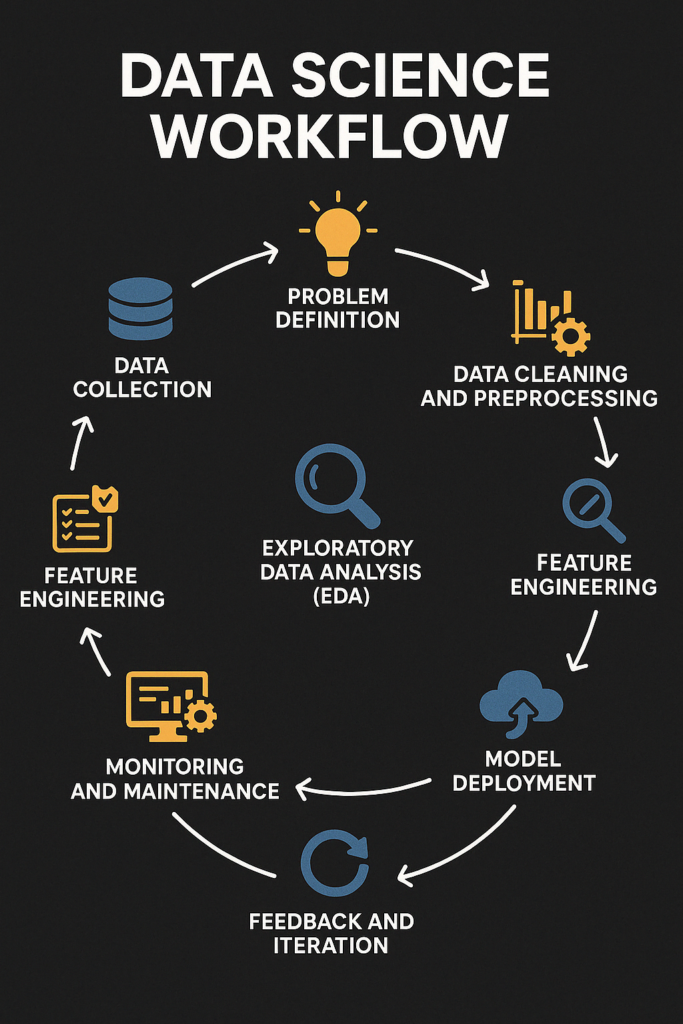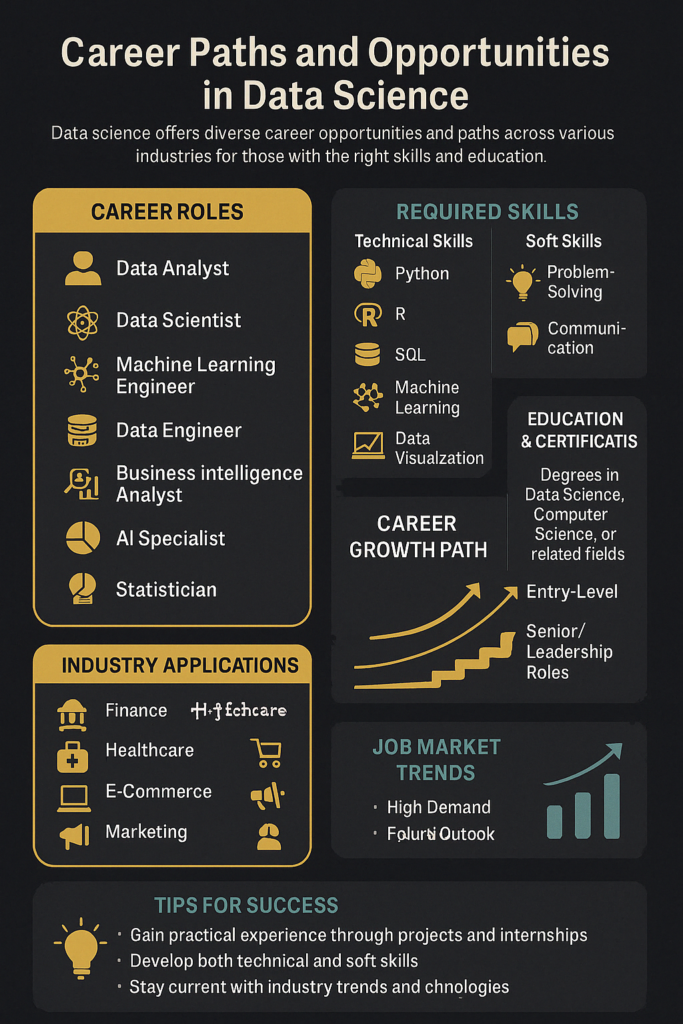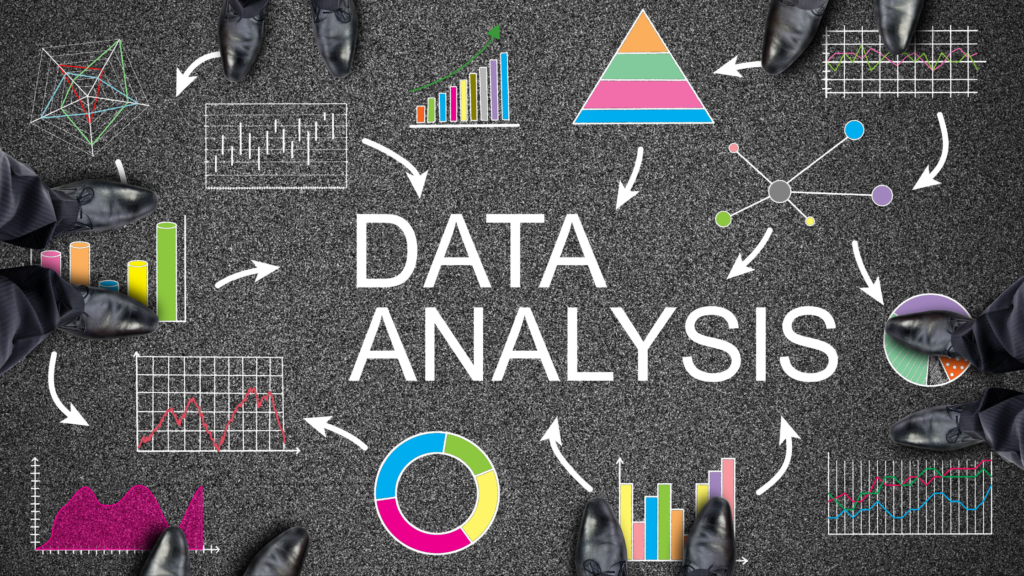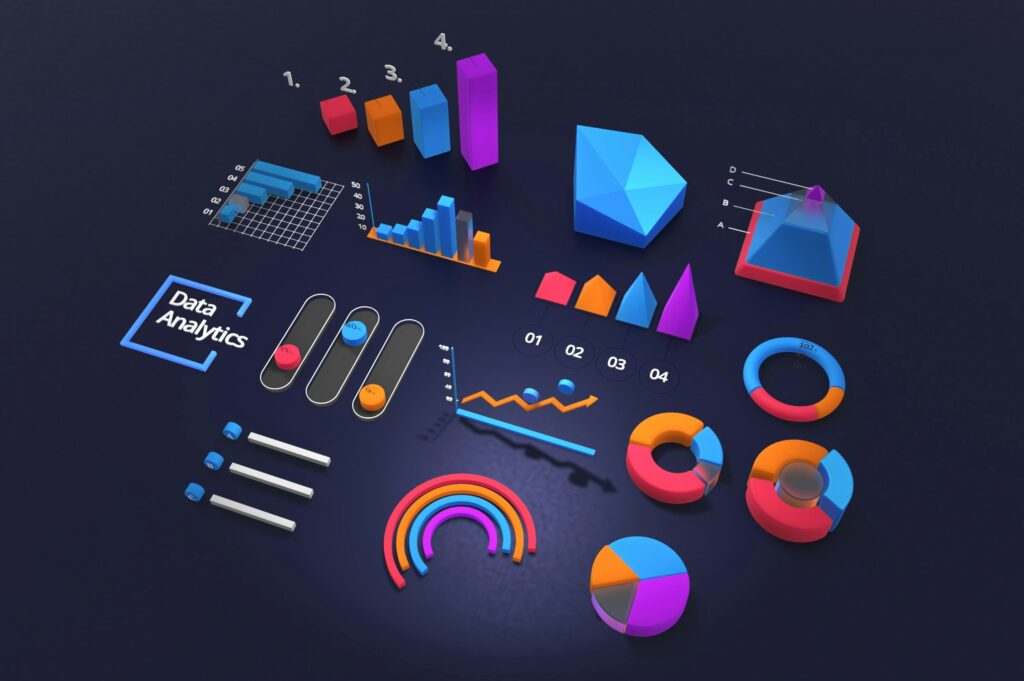Data Science: Definition, Components, Skills, Careers & Future Trends
Table of Contents
What is Data Science
Data Science is an interdisciplinary field that uses scientific methods, algorithms, and systems to extract knowledge and insights from structured and unstructured data. At its core, data science involves collecting data, cleaning and analyzing it, building predictive models, and interpreting the results to make informed decisions. It merges various domains such as computer science, statistics, machine learning, data visualization, and domain-specific knowledge. The goal of data science is to uncover patterns and trends in data that can help solve complex business problems or support decision-making.
The relevance of data science has grown significantly in recent years due to the exponential increase in data generation. With businesses and organizations collecting data at an unprecedented rate, the demand for professionals who can make sense of this data has skyrocketed. Data science helps in understanding customer behavior, improving operational efficiency, identifying new market opportunities, and even preventing fraud.
By leveraging modern computing tools, data science makes it possible to perform complex analyses in a relatively short amount of time. It also plays a crucial role in innovation by facilitating the development of new products, services, and business models. Thus, data science has become an essential driver of digital transformation in virtually every industry.
Importance of Data Science
The importance of data science can hardly be overstated. It plays a critical role in converting raw, often messy data into valuable insights that organizations can act on. In today’s data-driven economy, companies rely heavily on data science to maintain a competitive edge. From detecting fraudulent transactions in banking systems to enabling personalized customer experiences in e-commerce, the scope and influence of data science are enormous.
One of the key reasons for the importance of data science is its ability to automate and optimize decision-making processes. Instead of relying on intuition or guesswork, organizations use data science models to predict outcomes and recommend the best course of action. For example, predictive maintenance models in manufacturing help identify when machinery is likely to fail, reducing downtime and saving costs.
Moreover, data science has a democratizing effect by making powerful analytics accessible to businesses of all sizes. With cloud-based tools and open-source software, even startups can harness the power of data science to drive innovation. The combination of artificial intelligence, big data, and cloud computing has expanded the reach and impact of data science across various sectors, making it a cornerstone of modern enterprise.
Real-world Applications of Data Science
Data science is revolutionizing industries across the board, delivering actionable insights and automation capabilities. In healthcare, for instance, data science is used for predictive analytics that help doctors diagnose diseases earlier and more accurately. Hospitals use data science to manage resources efficiently, improve patient outcomes, and reduce operational costs.
In retail and e-commerce, companies like Amazon and Walmart analyze customer data to personalize product recommendations, optimize inventory, and develop targeted marketing strategies. By understanding buying patterns and preferences, businesses can increase customer satisfaction and loyalty.
The finance industry leverages data science for fraud detection, risk management, and customer segmentation. Credit scoring models, for example, analyze various data points to determine a borrower’s creditworthiness more accurately than traditional methods.
Transportation companies use data science for route optimization, fuel efficiency, and predictive maintenance. Logistics giants like FedEx and UPS utilize data analytics to ensure timely deliveries and manage fleets effectively. Similarly, autonomous vehicle developers rely heavily on data science for image recognition and real-time decision-making.
Even in sports, data science is being used for performance analysis, injury prevention, and strategic planning. Teams and athletes use wearable tech and analytics software to gain a competitive edge. These examples only scratch the surface of how versatile and impactful data science can be.
Key Components and Process Steps of Data Science
Data science comprises several critical components that work together to extract insights from data. Understanding these components is essential for anyone looking to pursue a career in the field or leverage data science in a business context.
Essential Components
- Data Collection: This is the first and most crucial step. It involves gathering data from various sources, including databases, APIs, IoT devices, web scraping, and user interactions. The quality and relevance of data collected significantly affect the outcomes of any data science project.
- Data Cleaning (Data Wrangling): Raw data is often messy, with missing values, inconsistencies, or duplicates. Data cleaning involves transforming this raw data into a usable format. This step ensures that the analysis is accurate and meaningful.
- Exploratory Data Analysis (EDA): EDA involves summarizing the main characteristics of the data, often using visual methods. It helps data scientists understand the structure of the data, identify trends, and detect anomalies or outliers.
- Data Modeling: This is where machine learning or statistical models are applied to the data to make predictions or uncover patterns. Choosing the right model is critical and depends on the problem being solved.
- Evaluation: Once a model is built, it must be evaluated for accuracy and performance. Common metrics include accuracy, precision, recall, F1-score, and RMSE (Root Mean Squared Error).
- Deployment: This step involves integrating the model into a production environment where it can provide real-time predictions or insights.
- Monitoring & Maintenance: After deployment, the model must be monitored to ensure it continues to perform well. Over time, data may change, requiring model updates.
Typical Data Science Workflow

A standard data science workflow begins with problem definition, where stakeholders outline the business goals. Once the objective is clear, data scientists move to the data acquisition phase, sourcing data from internal systems, third-party providers, or real-time feeds.
Next, the data preparation stage involves cleaning, normalizing, and transforming data to ensure it is suitable for analysis. During exploratory data analysis, data scientists use visualizations and statistical methods to get a deeper understanding of the data’s structure and relationships.
Modeling follows, where appropriate algorithms are selected and trained on historical data. Evaluation helps in selecting the best-performing model using various metrics. If the results are satisfactory, the model is deployed into the production environment where it can support decision-making or automate tasks.
Finally, monitoring and maintenance ensure that the model adapts to new data and changing business environments. This cyclical process ensures continuous improvement and value generation.
Required Skills and Tools
To become a successful data scientist, one must master a blend of technical and soft skills. These skills help in extracting, analyzing, and interpreting data effectively.
Core Skills for Data Science Enthusiasts
- Programming: Knowledge of programming languages like Python and R is essential. Python is widely used for its simplicity and robust libraries, while R is powerful for statistical analysis.
- Mathematics & Statistics: Understanding concepts such as linear algebra, calculus, probability, and hypothesis testing is crucial for data analysis and building machine learning models.
- Machine Learning: Familiarity with algorithms like regression, classification, clustering, and neural networks enables data scientists to create predictive and prescriptive models.
- Data Visualization: Skills in visualizing data using charts, graphs, and dashboards help in communicating insights to stakeholders.
- Database Management: Knowledge of SQL for querying relational databases and understanding NoSQL systems like MongoDB is vital for data handling.
- Communication Skills: The ability to translate complex data findings into clear, actionable insights is invaluable, especially when working with non-technical teams.
Tools and Technologies
- Languages: Python, R, SQL, Java, Scala
- Libraries: Pandas, NumPy, Matplotlib, Seaborn, Scikit-learn, TensorFlow, Keras, PyTorch, XGBoost
- Visualization Tools: Tableau, Power BI, D3.js
- Big Data Tools: Apache Hadoop, Apache Spark, Hive, Kafka
- Cloud Services: AWS (Amazon SageMaker, Redshift), Google Cloud (BigQuery, AutoML), Microsoft Azure (Azure ML, Synapse Analytics)
- Version Control: Git, GitHub, GitLab for collaboration and versioning of code
- Integrated Development Environments (IDEs): Jupyter Notebook, RStudio, VS Code, PyCharm
These tools enable data scientists to handle everything from data extraction and cleaning to modeling and deployment. Mastery of these tools and platforms allows professionals to work efficiently and at scale.
Career Paths and Opportunities in Data Science
Data science offers diverse career opportunities, each with its own specialization and scope. As the demand for data-driven decision-making grows, so do the number of roles and paths one can pursue in the data science domain.

Popular Job Roles
- Data Analyst: Focuses on interpreting structured data, generating reports, and identifying trends. They often use tools like Excel, SQL, and Power BI.
- Data Scientist: Uses statistical and machine learning techniques to analyze data and build predictive models. They work with complex datasets and often communicate results to stakeholders.
- Machine Learning Engineer: Designs and deploys scalable ML models into production. Requires strong software engineering and ML knowledge.
- Data Engineer: Responsible for creating and managing data pipelines and architecture. They ensure that data is accessible, clean, and properly stored.
- Business Intelligence Analyst: Translates data into actionable business insights using dashboards and data visualizations.
- AI Research Scientist: Works on developing advanced AI algorithms, often within academic or R&D settings.
Career Outlook
The future of data science careers is bright. According to the U.S. Bureau of Labor Statistics, employment in data science-related fields is projected to grow by 36% from 2021 to 2031—much faster than the average for all occupations. This demand is fueled by the digital transformation of industries, increased use of AI, and the explosion of data generated daily.
Entry-level positions offer competitive salaries, and with experience, professionals can move into leadership roles such as Chief Data Officer or Head of Analytics. Freelance and consulting opportunities are also growing as companies seek flexible access to data science expertise. The global nature of the industry means there are opportunities worldwide, and many roles are remote-friendly, offering further flexibility.
Future Trends and Development in Data Science
Data science is experiencing a dynamic evolution, fueled by significant technological advancements and the shifting needs of society. As new tools, methodologies, and applications emerge, professionals in this field must remain vigilant and informed about the latest trends and developments. Keeping up-to-date is not just beneficial; it’s essential for successfully navigating the complexities and challenges of this ever-changing landscape.
AI and Deep Learning Advancements
The field of deep learning, particularly with the use of architectures like transformers, is greatly enhancing the capabilities of AI systems. Models such as GPT and BERT have revolutionized natural language processing (NLP), facilitating the development of chatbots, automated summarizers, self-supervised learning models, agentic AI models, and more. In the realm of computer vision, convolutional neural networks (CNNs) are driving advancements in applications like medical image analysis and facial recognition.
Big Data and Real-Time Analytics
Organizations are increasingly managing large volumes of data from diverse sources such as IoT devices, mobile applications, and social media. Big data tools like Apache Kafka, Spark Streaming, and Flink facilitate real-time processing and edge computing, enabling businesses to respond swiftly to changing conditions.
Data Privacy and Ethics
As regulations such as GDPR become more prevalent and public awareness of data privacy increases, ethical data practices are essential. Key considerations in any data science project now include transparency in algorithms, bias detection, data anonymization, and responsible use of AI.
AutoML and Low-Code Platforms
AutoML platforms automate the entire process of applying machine learning to real-world problems. Tools like Google Cloud AutoML, DataRobot, and H2O.ai, as well as AI-assisted coding and AI-driven agent creation tools on low-code platforms, enable faster deployment of machine learning solutions, even for users with limited coding skills. This democratization of data science fosters innovation and accelerates progress in the field.
Integration with Business Strategy
Data science has transitioned from being merely a backend support function to becoming vital for strategic planning and decision-making. Organizations are integrating data science into every department—from marketing to human resources—to obtain comprehensive insights and cultivate a data-driven culture.
These trends indicate a future where data science is not only a technical discipline but also a foundational element for both business and societal progress.
Useful Resources
- Top Trending Programming Languages for Data Science in 2025
- How to Enhance Your Data Analysis with Advanced Visualization in Python
- Data Science Career: Mastering the Art of Staying Updated
- Machine Learning using Logistic Regression
- How AI Is Transforming Business Analytics: Trends, Benefits, and Challenges
Final Thoughts
Data science is not just a buzzword—it’s a transformative force reshaping industries and solving real-world problems. With data playing an ever-increasing role in decision-making and innovation, understanding the core principles and practices of data science is essential for anyone looking to thrive in the modern digital economy.
Whether you’re an aspiring data professional, a business leader, or someone curious about how data impacts the world, mastering data science can open doors to countless opportunities. By continuously learning, adapting to new tools, and staying informed on trends, you can build a rewarding and impactful career in this exciting field.
For regular insights and curated news, join our Data Science Demystified community




Wow that was unusual. I just wrote an extremely long comment but after I clicked submit my comment didn’t appear. Grrrr… well I’m not writing all that over again. Anyway, just wanted to say excellent blog!
Enjoyed reading this, very good stuff, thankyou.